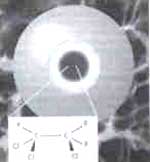Curtailing CFCs
 WITH the production of chlorofluorocarbons (CFCs) coming to a slow stop as a consequence of the Montreal Protocol of 1987, efforts are now directed towards its disposal. Large amounts of this ozone depleting chemical are being collected from aerosols, insulation foams and cooling units for its final denouement. Breaking down this nonflammable and inert chemical requires expensive methods involving high temperatures and jets of hot ionized gases.
WITH the production of chlorofluorocarbons (CFCs) coming to a slow stop as a consequence of the Montreal Protocol of 1987, efforts are now directed towards its disposal. Large amounts of this ozone depleting chemical are being collected from aerosols, insulation foams and cooling units for its final denouement. Breaking down this nonflammable and inert chemical requires expensive methods involving high temperatures and jets of hot ionized gases.
A group of scientists headed by Yoshio Nagata from the Research Institute for Advanced Science and Technology at Osaka University in Japan have discovered that CFCs can be broken down in water at room temperature using sound waves, the frequency of which is too high for humans to hear (New Scientist, Vol 146, No 1979).
Pulses of ultrasound at a frequency of 200 kilohertz were found to cause CFC- 113, the commonest Of CFCs, to react with water in a dilute solution of the compound. Tiny bubbles are formed that on collapsing generate high temperature and pressure. This splits water molecules to release highly reactive hydroxyl (oH) radicals, which in turn attack the cFc molecules. Carbon dioxide and carbon monoxide along- with hydrochloric and hydrofluoric acids are formed, which can be easily disposed of Researchers found that the technique destroyed 80 per cent of the dissolved CFC-113 within 30 minutes, increasing the temperature of water from 22'c to 30'c only.
